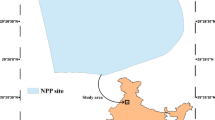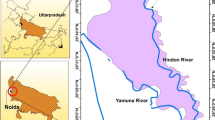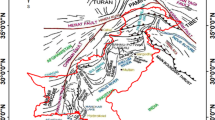Abstract
Deterministic seismic hazard analysis (DSHA) is carried out for the state of Goa, which is a small but one of the most popular touristic places on the west coast of peninsular India. Goa state is located about 250 km from Koyna region which experienced a 6.3 magnitude earthquake in 1967 and about 350 km from Latur which witnessed a 6.3 magnitude earthquake in 1993. Hence, it is important to carry out the seismic hazard analysis for Goa, such studies being scarce in literature till date. In this paper, DSHA for Goa is carried out by considering a 350 km distance from the state boundary taking into account the historic seismicity and identifying active faults and lineaments. Seven attenuation relationships developed for intraplate regions and shallow crustal earthquakes including one developed specifically for peninsular India are used. Three earthquake scenarios representing three levels of seismic activity are considered using the logic tree approach. The maximum magnitude estimated by empirical relations and the same from past earthquake events are considered in two scenarios for carrying out the DSHA, and the third scenario is derived from the previous two scenarios using equal weightage. The peak ground acceleration (PGA) values are obtained by considering a grid of 0.1° × 0.1° (i.e., 11.1 km × 11.1 km) covering the entire state of Goa. The deterministic seismic hazard map showing contours of PGA are developed for the state of Goa for the three scenarios. For the mildest scenario 2, highest hazard with PGA of 0.15 g is found at localized areas in the southwest of Goa. The hazard maps for the severe scenarios indicate high hazard in the central band of the state. The deterministic spectra are developed for five major cities of Goa and compared with the spectra given in Indian seismic code IS 1893-Part 1 (Criteria for Earthquake resistant design of structures. Bureau of Indian standards, New Delhi, 2002). PGA map and the spectra will be very useful for seismic design of important structures in Goa.










Similar content being viewed by others
References
Abrahamson NA, Litehiser JJ (1989) Attenuation of vertical peak accelerations. Bull Seismol Soc Am 79:549–580
Abrahamson NA, Silva WJ (1997) Empirical response spectral attenuation relations for shallow crustal earthquakes. Seismol Res Lett 68(1):94–127
Atkinson GM and Boore DM (1995) Ground-motion relations for eastern North America. Bull Seismol Soc Am 85:17–30
Atkinson GM, Boore DM (2006) Earthquake ground-motion prediction equations for eastern North America. Bull Seismol Soc Am 96(6):2181–2205
Bilham R, Gaur VK (2011) Historical and future seismicity near Jaitapur, India. Curr Sci 101(10):1275–1281
Bonilla MG, Mark RK, Lienkaemper JJ (1984) Statistical relations among earthquake magnitude, surface rupture length and surface fault displacement. Bull Seismol Soc Am 74:2379–2411
Boominathan A, Dodagoudar GR, Suganthi A, Maheswari UR (2008) Seismic hazard assessment of Chennai city considering local site effects. J Earth Syst Sci 117(S2):853–863
Boore DM (1983) Stochastic simulation of high-frequency ground motions based on seismological models of the radiated spectra. Bull Seismol Soc Am 73:1865–1894
Boore DM, Joyner WB, Fumal TE (1997) Equations from estimating horizontal response spectra and peak acceleration from western North American earthquakes: a summary of recent work. Seismol Res Lett 68:128–153
Campbell KW (1997) Empirical near-source attenuation relationships for horizontal and vertical components of peak ground acceleration, peak ground velocity and pseudo-absolute acceleration response spectra. Seismol Res Lett 68(1):154–179
Chopra S, Kumar D, Rastogi BK, Choudhury P, Yadav RBS (2012) Deterministic seismic scenario for Gujarat region, India. Nat Hazards 60(2):2517–2540
Choudhury D, Shukla J (2011) Probability of occurrence and study of earthquake recurrence models for Gujarat state in India. Disaster Adv 4(2):47–59
Choudhury D, Phanikanth VS, Mhaske SY, Phule RR, Chatterjee K (2014) Seismic liquefaction hazard and site response for design of piles in Mumbai city. Indian Geotech J. doi:10.1007/s40098-014-0108-4
Costa G, Panza GF, Suhadolc P, Vaccari F (1993) Zoning of the Italian territory in terms of expected peak ground acceleration derived from complete synthetic seismograms. J Appl Geophys 30:149–160
Desai S, Choudhury D (2014a) Deterministic seismic hazard analysis for greater Mumbai, India, In Geo-Congress 2014: geotechnical Special Publication No. GSP 234, ASCE, 389–398, doi:10.1061/9780784413272.038
Desai SS, Choudhury D (2014b) Spatial variation of probabilistic seismic hazard for Mumbai and surrounding region. Nat Hazards 71(3):1873–1898. doi:10.1007/s11069-013-0984-4
Desai SS, Choudhury D (2014c) Deaggregation of seismic hazard for two ports in Mumbai metropolitan region, In International conference on geotechnical engineering, GeoShanghai 2014: advances in soil dynamics and foundation engineering GSP 240, ASCE, 62–71, doi:10.1061/9780784413425.008
ESRI (2011) ArcGIS Desktop: Release 10. Environmental Systems Research Institute (ESRI), Redlands
GSI (2000) Seismotectonic atlas of India and its environs. Geological survey of India
GSI (2006) Geology and mineral resources of India, Part VII—Karnataka and Goa. Miscellaneous publication no. 30. Geological survey of India
Hull AG, Augello A, Yeats RS (2003) Deterministic seismic hazard analysis in Northwest Oregon, USA. Pacific conference of earthquake engineering. Paper no. 157
IS 1893-Part 1 (2002). Criteria for Earthquake resistant design of structures. Bureau of Indian standards, New Delhi
Iyengar RN, Raghukanth STG (2004) Attenuation of ground motion in Peninsular India. Seismol Res Lett 79:67–81
Kolathayer S, Sitharam TG, Vipin KS (2012) Deterministic seismic hazard macrozonation of India. J Earth Syst Sci 121:1351–1364
Kramer SL (1996) Geotechnical earthquake engineering. Prentice Hill, New Jersey
Kumar A, Anbazhagan P, Sitharam TG (2013) Seismic hazard analysis of Lucknow considering local and active seismic gaps. Nat Hazards 69:327–350
Mhaske SY, Choudhury D (2010) GIS-based soil liquefaction susceptibility map of Mumbai city for earthquake events. J Appl Geophys 70(3):216–225. doi:10.1016/j.jappgeo.2010.01.001
Mhaske SY, Choudhury D (2011) Geospatial contour mapping of shear wave velocity for Mumbai city. Nat Hazards 59(1):317–327. doi:10.1007/s11069-011-9758-z
Moratto L, Orlecka SB, Costa G, Suhadolc P, Papaioannou C, Papazachos CB (2007) A deterministic seismic hazard analysis for shallow earthquakes in Greece. Tectonophysics 442:66–82
Muco B, Vaccari F, Panza G, Kuka N (2002) Seismic zonation in Albania using a deterministic approach. Tectonophysics 344:277–288
Naik NP, Choudhury D (2014a) Comparative study of seismic ground responses using DEEPSOIL, SHAKE and D-MOD for soils of Goa, India, In Geo-Congress 2014: Geotechnical Special Publication No. GSP 234, ASCE, 1101–1110, doi:10.1061/9780784413272.107
Naik N, Choudhury D (2014b) Development of fault and seismicity maps for the state of Goa, India. Disaster Adv 7(6):12–24
Nowroozi AA (1985) Empirical relations between magnitudes and fault parameters for earthquakes in Iran. Bull Seismol Soc Am 75:1327–1338
Parvez IA, Vaccari F, Giuliano FP (2003) A deterministic seismic hazard map of India and adjacent areas. Geophys J Int 155:489–508
Phanikanth VS, Choudhury D, Reddy GR (2011) Equivalent-linear seismic ground response analysis of some typical sites in Mumbai. Geotech Geol Eng 29(6):1109–1126
Raghukanth STG, Iyengar RN (2007) Estimation of seismic spectral acceleration in peninsular India. J Earth Syst Sci 3:199–214
Sadigh K, Chang CY, Egan JA, Makdisi F, Youngs RR (1997) Attenuation relations for shallow crustal earthquakes based on California strong motion data. Seismol Res Lett 68:180–189
Schulte SM, Mooney WD (2004) An updated earthquake catalog for stable continental regions, Intraplate earthquakes (495-2002). United States Geological Survey. http://earthquake.usgs.gov/research/data
Scordilis EM (2006) Empirical global relations converting Ms and mb to moment magnitude. J Seismol 10:225–236
Shiuly A, Narayan JP (2012) Deterministic seismic microzonation of Kolkata. Nat Hazards 60:223–240
Shukla J, Choudhury D (2012a) Estimation of seismic ground motions using deterministic approach for major cities of Gujarat. Nat Hazards Earth Syst Sci 12:2019–2037. doi:10.5194/nhess-12-2019-2012
Shukla J, Choudhury D (2012b) Seismic hazard and site-specific ground motion for typical ports of Gujarat. Nat Hazards 60(2):541–565. doi:10.1007/s11069-011-0042-z
Sitharam TG, Anbazhagan P (2007) Seismic hazard analysis for the Bangalore region. Nat Hazards 40:261–278
Slemmons DB, Bodin P, Zhang X (1989) Determination of earthquake size from surface faulting events. Proceedings of international seminar on seismic zonation, Guangzhou, China pp 157–169
Thaker TP, Rathod GW, Rao KS, Gupta KK (2012) Use of seismotectonic information for the seismic hazard analysis for Surat city, Gujarat, India: deterministic and probabilistic approach. Pure ApplGeophys 169(2):37–54
Toro GR, Abrahamson NA, Schneider JF (1997) Model of strong ground motions from earthquakes in central and eastern North America: best estimates and uncertainties. Seismol Res Lett 68:41–58
Vaccari F, Tadili B, El Qadi A, Ramdani M, Ait Brahim L, Limouri M (2001) Deterministic seismic hazard assessment for North Morocco. JSEE 3(1):1
Weatherill G, Burton PW (2010) An alternative approach to probabilistic seismic hazard analysis in the Aegean region using Monte Carlo simulation. Tectonophysics 492:253–278
Wells DL, Coppersmith KJ (1994) New empirical relationships among magnitude, rupture length, rupture width, rupture area and surface displacement. Bull Seismol Soc Am 84(4):974–1002
Author information
Authors and Affiliations
Corresponding author
Rights and permissions
About this article
Cite this article
Naik, N., Choudhury, D. Deterministic seismic hazard analysis considering different seismicity levels for the state of Goa, India. Nat Hazards 75, 557–580 (2015). https://doi.org/10.1007/s11069-014-1346-6
Received:
Accepted:
Published:
Issue Date:
DOI: https://doi.org/10.1007/s11069-014-1346-6




